Standards Worldwide
Standards Worldwide
Phone +49 30 58885700-07

Standard [CURRENT]
ASTM D 6103/D 6103M:2017
Standard Test Method for Flow Consistency of Controlled Low Strength Material (CLSM)
- Publication date
- 2017
- Original language
- English
- Pages
- 4
- Note
- The publisher recommends this document in lieu of the withdrawn document ASTM D 6103:2004 , for which no replacement is available.
- Publication date
- 2017
- Original language
- English
- Pages
- 4
- Note
- The publisher recommends this document in lieu of the withdrawn document ASTM D 6103:2004 , for which no replacement is available.
- DOI
- https://dx.doi.org/10.1520/D6103_D6103M-17E01
Product information on this site:
Quick delivery via download or delivery service
Buy securely with a credit card or pay upon receipt of invoice
All transactions are encrypted
Short description
1.1 This test method covers the procedure for determination of the flow consistency of fresh Controlled Low Strength Material (CLSM). This test method applies to flowable CLSM with a maximum particle size of 19.0 mm [3/4 in.] or less, or to the portion of CLSM that passes a 19.0 mm [3/4 in.] sieve. 1.2 The CLSM used to make the molded specimens shall be sampled after all on-site adjustments have been made to the mixture proportions, including the addition of mix water and any admixtures. 1.3 All observed and calculated values shall conform to the guidelines for significant digits and rounding established in Practice D6026 unless superseded by this test method. 1.3.1 The method used to specify how data are collected, calculated, or recorded in this standard is not directly related to the accuracy to which the data can be applied in design or other uses, or both. How one applies the results obtained using this standard is beyond its scope. 1.4 Units- The values stated in either SI units or inch-pound units (presented in brackets) are to be regarded separately as standard. The values stated in each system shall be used independently of the other. Combining values from the two systems may result in non-conformance with the standard. 1.4.1 The gravitational system of inch-pound units is used when dealing with inch-pound units. In this system, the pound (lbf) represents a unit of force (weight) while the unit for mass is slugs. The rationalized slug unit is not given, unless dynamic (F=ma) calculations are involved. 1.4.2 It is common practice in the engineering/construction profession to concurrently use pounds to represent both a unit of mass (lbm) and of force (lbf). This implicitly combines two separate systems of units: that is, the absolute system and the gravitational system. It is scientifically undesirable to combine two separate sets of inch-pound units within a single standard. As stated, this standard includes the gravitational system of inch-pound units and does not use/present the slug unit for mass. However, the use of balances or scales recording pounds of mass (lbm) or recording in lbm/ft3 shall not be regarded as nonconformance with this standard. 1.5 CLSM is also known as flowable fill, controlled density fill, soil-cement slurry, soil-cement grout, unshrinkable fill, K-Krete, and other similar names. 1.6 The text of this standard references notes and footnotes which provide explanatory material. These notes and footnotes (excluding those in tables and figures) shall not be considered as requirements of the standard. 1.7 This standard does not purport to address all of the safety concerns, if any, associated with its use. It is the responsibility of the user of this standard to establish appropriate safety, health, and environmental practices and determine the applicability of regulatory limitations prior to use. 1.8 This international standard was developed in accordance with internationally recognized principles on standardization established in the Decision on Principles for the Development of International Standards, Guides and Recommendations issued by the World Trade Organization Technical Barriers to Trade (TBT) Committee.
ICS
91.100.99
DOI
https://dx.doi.org/10.1520/D6103_D6103M-17E01
Also available in
Loading recommended items...
Loading recommended items...
Loading recommended items...
Loading recommended items...
